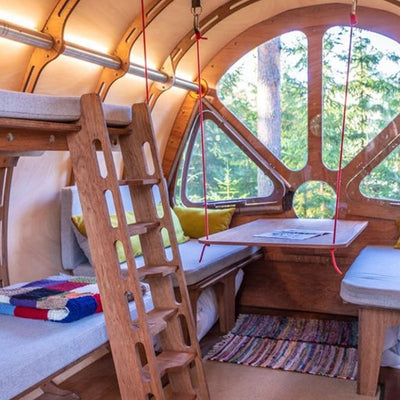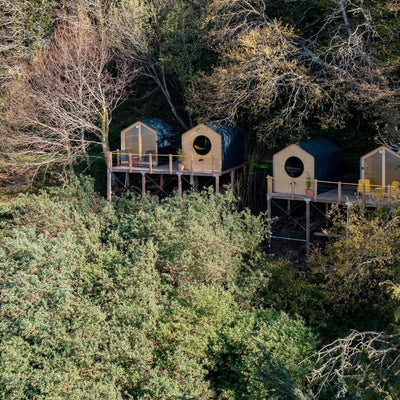Texas, with its vast landscapes and booming tourism (over 71 million visitors in 2023 according to Travel Texas), is a hotspot for glamping ventures. From the Hill Country’s rolling hills to Big Bend’s desert allure, the Lone Star State offers prime real estate for unique stays. But how do you get a glamping site up and running here? We've gathered up the info from aspiring entrepreneurs and seasoned hosts to help reveal the highs, lows, and must-knows of starting a glamping operation in Texas. Here’s a distilled guide to help you launch your glamorous dream campground.
 1. Pick the Right Location
1. Pick the Right Location
Glamping hopefuls stress location as king. One campground owner planned a site but highlighted Texas-specific concerns like zoning and water access—key for any Lone Star setup.
- Tip: Target tourist draws like Lake Livingston, the Hill Country, or Big Bend. Reddit threads rave about glamping near Lake Texoma, just a few hours from DFW, showing proximity to cities boosts appeal.
- Action: Scout land on sites like LandWatch—aim for 2–10 acres in rural zones (cheaper, less regulated) with natural features (rivers, views). Check drive times from Austin, Dallas, or Houston for guest convenience.
2. Navigate Zoning and Permits
Texas zoning can vary wildly by county, planning permission could be a challenge, even in tourist-friendly areas, while rural Texas might offer more leeway.
- Tip: Rural counties like Brewster (near Big Bend) often have laxer rules than urban hubs like Travis (Austin). Call the county planning office—e.g., Burnet County for Hill Country—to confirm if glamping tents or cabins are allowed as “temporary structures” or need a conditional use permit.
- Action: Budget $500–$2,000 for permits and consult a local land use attorney if zoning’s murky. As always, you're going to want to try to avoid unpermitted setups, unless you're in the "ask-for-forgiveness-later" camp, but that's your call!
 3. Choose Your Structures
3. Choose Your Structures
There's some debate tents vs. pods vs. cabins. Some start-ups favor tents for low startup costs (our answer to that is the Airspace!), while others opt for structures like domes which can end up costing $100K for three units, not including furnishings.
- Tip: Start lean with something you can get up and running quickly to get a head start on ROI. Both our Tree Tent and the Airspace are quick to install (2-3 days and half a day respectively), and absolutely scream when users are browsing STR site listings. Upgrade to more luxury cabins like our Birdhouse or Fuselage as revenue rolls in.
- Action: Factor Texas heat—think about incorporating A/C units to keep guests comfy in summer.
4. Solve Water and Waste
Water and sanitation stump many newbies. Think flushing toilets and water for showers.
- Tip: Off-grid? Use rainwater tanks ($500+) and composting toilets like The Outhouse from Tree Tents—Reddit loves their eco-appeal and ease. On-grid? Tap into wells or septic systems (permit costs: $5,000–$15,000).
- Action: Budget for a 1,000-gallon tank and a greywater system ($150+) to stay sustainable. Texas health codes (TAC 228) require sanitary facilities—don’t skimp.
 5. Budget and Fund It
5. Budget and Fund It
Research your financing options. Start-up Campground can be difficult to get bank funding for and alternative options are available with a little creativity.
- Tip: Bootstrap with $20K–$50K for 1–2 units (tents, outhouse, basics). But don't expect bookings right away with no marketing.
- Action: Test viability with one site before scaling. Seek angel investors or partners if cash is tight—banks may lend post-revenue. (If you're interested in financing, let us know, we've got solutions)
6. Market and Operate
Marketing chatter online stresses standing out. A Houston host spent a year researching Lake Livingston’s draw, while others pushed realistic occupancy (60–70%).
- Tip: List on Airbnb, Hipcamp, and Glamping Hub—Reddit users loved Hipcamp finds. Highlight eco perks (e.g., Outhouse composting) and Texas charm (stargazing, BBQ pits).
- Action: Budget $500–$1,000 for initial ads and hire a local manager or automate bookings via software like ResNexus.
 7. Avoid Pitfalls
7. Avoid Pitfalls
Online horror stories warn of:
- Theft/Damage: Install cameras or hire a camp host (National Parks trick).
- Weather: Texas heat and storms demand sturdy gear—anchor tents well.
- Bad Guests: Set rates high ($150-300+/night) for quality bookings.
Texas Glamping: Worth It? Yes!
So what's the consensus? Starting a glamping operation in Texas takes a little grit—zoning, weather, and startup costs are real hurdles. But with $150–$400/night potential and 70% occupancy, a 5-unit site could net $60-200K+ annually after expenses. Pick a spot like the Hill Country or near Big Bend, lean on Tree Tents' eco solutions, and play by the rules. Your glampground could be the next Texas gem—start small, plan smart, and let other's lessons guide you.





